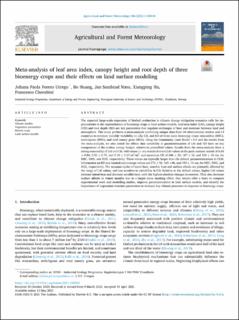| dc.description.abstract | The expected large-scale expansion of biofuel production in climate change mitigation scenarios calls for improvements in the representation of bioenergy crops in land surface models. Leaf area index (LAI), canopy height (CH) and root depth (RD) are key parameters that regulate exchanges of heat and moisture between land and atmosphere. This study performs a meta-analysis combining unique data from 34 observational studies and 14 countries to estimate monthly variability in LAI, CH, and RD of three main bioenergy crops: miscanthus (MSC), switchgrass (SWG), and reed canary grass (RCG). Using the Community Land Model v.5.0 and the results from the meta-analysis, we also tested the effects that variability in parameterization of LAI and CH have on key components of the surface energy budget, relative to prescribed values. Results from the meta-analysis show a strong seasonality of LAI and CH, with mean (± one standard error) LAI values at the peak summer month of 6.05 ± 0.84, 5.56 ± 0.75, and 5.39 ± 1.15 m2/m2, and maximum CH of 246 ± 23, 147 ± 16, and 156 ± 10 cm, for MSC, SWG, and RCG, respectively. These values are typically larger than the default parameterizations in CLM. Information on RD was limited and average values are 172 ± 56, 165 ±46, and 193 ± 11 cm, for MSC, SWG, and RCG, respectively. The seasonal cycles of latent heat, sensible heat and surface albedo are primarily affected by the range of LAI values, and less sensitive to variability in CH. Relative to the default values, higher LAI values increase latent heat and decrease sensible heat, with the highest absolute changes in summer. They also decrease surface albedo in winter months due to a larger snow masking effect. Our results offer a basis to compare experimental work and modelling studies, improve parameterization in land surface models, and identify the importance of vegetation structure parameters to evaluate key climate processes in response to bioenergy crops. | en_US |

